Haris A. Kalligas / Χάρις Α. Καλλιγά
(Architect – Historian)
Kalligas was the director of the Gennadius Library, Athens, Greece 1995-2004

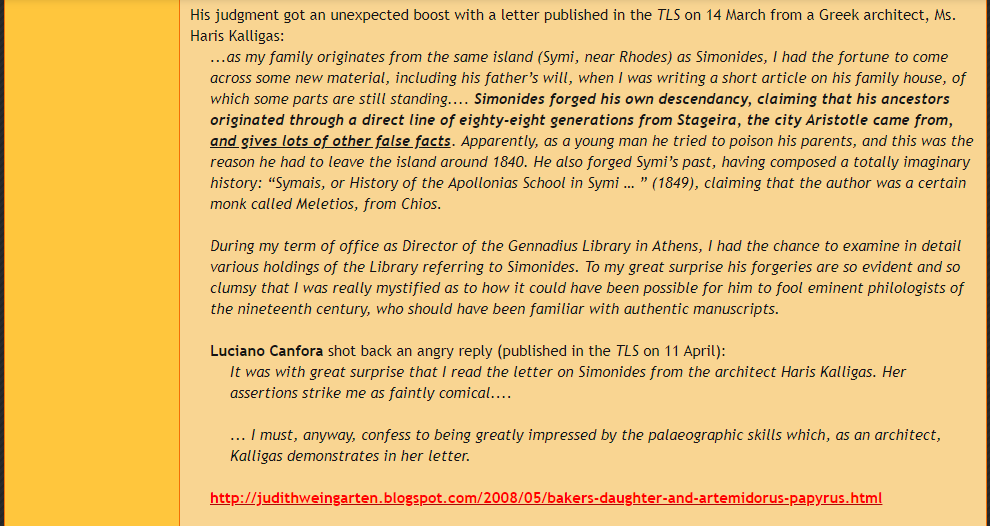

There is an old Latin manuscript in the Vatican Library dated to the sixth century A.D./C.E., which has a Commentary on “the Song of Solomon” (or “Canticles”), attributed to a man who was a companion of Jerome, and was the Bishop (or overseer) of Cyprus, Epiphanius of Salamis (circa. 310/320-403 A.D./C.E.).
The Commentary would have been written in Greek originally, but has been translated into Latin at some stage in history.
Vat. lat. 5704 (circa. 6th century A.D./C.E.) Folios 11v-12r.
https://digi.vatlib.it/view/MSS_Vat.lat.5704
Here on Folio 4v, we have the title heading (or Incipit): “Incipit Expositio Epiphanii Episcopi Cyprii In Canticis Canticorum”.
Then on Folio 96v, at the end of the Commentary, we have the end heading (or Explicit) “Expliciunt Commenta Epipha[nius]“.
The Folio where the writer quotes 1 John 5:7-8 in Latin at the very bottom line of Folio 11v and into the top line of Folio 12r.
Here’s the same images of the text of 1 John 5:7-8 highlighted in red.
There is no Comma (Parenthetical Text) in this quotation.
The Latin text of 1 John 5:7-8
“Quia tres sunt, qui testificantur, aqua et sanguis et Spiritus, et quia tres unum sunt.”
The Latin text was published in print form by Pietro Francesco Foggini in 1750. It’s important to note that Foggini was a devoted Catholic, and also worked in the Vatican itself, so it’s not surprising to see in his footnote on the 1 John 5:7-8 quotation, that he’s in favor of the Comma.
Here’s his text.
Sanctus Constantiae archiepiscopus Epiphanius · 1750
S. Epiphanius in Canticum Canticorum
Publication date 1750
Pietro Francesco Foggini
https://archive.org/details/bub_gb_01xqwhnhdioC
https://archive.org/details/bub_gb_01xqwhnhdioC/page/n61/mode/1up?view=theater
The beginning of the Commentary is on Page 5.
The relevant part (and context) of the Commentary begins on Page 8 and goes through to Page 11.
Page 9
Page 10

Here’s the Page 10 footnote to 1 John 5:7-8 enlarged.
Page 11
It is possible that this commentary could be by Epiphanius’ contemporary Philo of Carpathia (circa. 4th century A.D./C.E.) but this Latin version doesn’t line up with what remains of Philo’s Greek version.
It’s textual value lies, not so much in it’s author (whoever that might have been) but in it’s age, a sixth century A.D./C.E. Latin manuscript.
The Latin text of 1 John 5:7-8, “Quia tres sunt, qui testificantur, aqua et sanguis et Spiritus, et quia tres unum sunt.”
The good people at the University of Michigan have kindly put (in response to my request) the exact folio of fourth century A.D. (C.E.) manuscript Papyrus Michigan 3520 with the text of 1 John 5:7-8 in Fayumic Coptic online for everyone to enjoy.
This manuscript is possibly (note, possibly) the oldest of the extant text of 1 John 5:7-8 in existence. Possibly even older than the Greek unicial manuscripts of this passage (Siniaticus, Alexandrianus, Vatican 1209).
Ann Arbor Library, Michigan University, Library P. 3520 [Papyrus Michigan 3520]
Coptic Fayumic dialect F4, (circa. 4-5th century C.E.)
Official citation:
“P.Mich.inv. 3520; Recto.” https://quod.lib.umich.edu/a/apis/x-16722/3520_p24_57.tif. University of Michigan Library Digital Collections. Accessed: September 12, 2021.

Below shows where on the folio 1 John 5:7-8 is found in Coptic:

Schenke / Kasser, Papyrus Michigan 3520 und 6868(a) (Texte und Untersuchungen 151) p. 44-191 (Schenke, Hans-Martin / Kasser, Rodolphe) 2003
Page 20 helped me to find the right folio.
Page 152 gives a reproduction of the text:
Same text enlarged:
The printed text alongside the manuscript itself:

Enlarged image. I’ve put the verse numbering roughly where they are in the printed text. Number 9 should be a little more to the right, but close enough. You get the general idea.
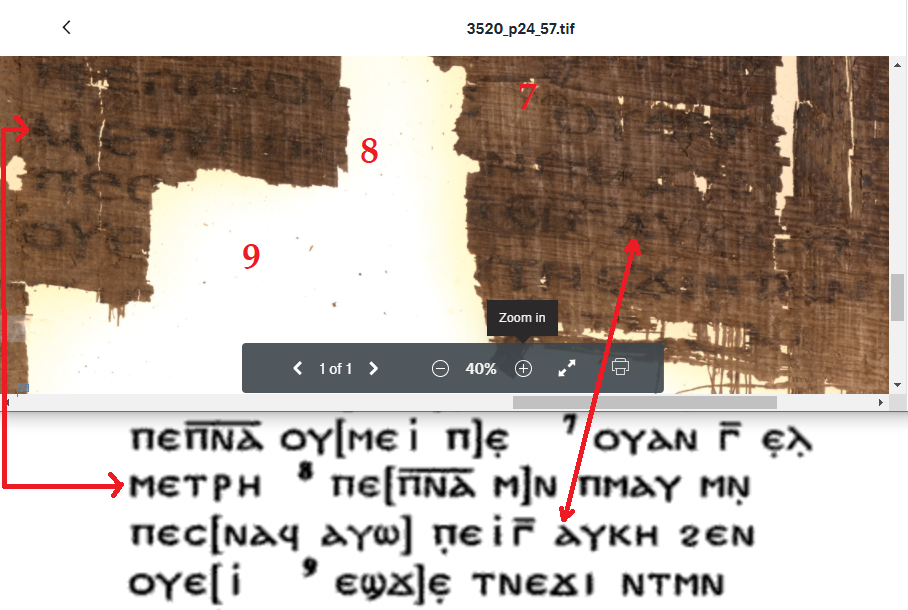
Acknowledgement.
I would like to give a big thankyou to Monica Tsuneishi from the University of Michigan for being so nice to deal with and for processing my request so quickly. Thank you so much.
This is an extremely valuable witness to the Bible text of 1 John 5:7-8.
It does not contain the Comma Johanneum (or Johannine Comma).



Egypt, Sinai, Saint Catherine’s Monastery, N.E. ΜΓ Σπ. 48, 53, 55, 0296.1 [GA 0296] (circa. 6th century C.E.) Uncial 0296 (Gregory-Aland numbering) is one of a number of New Testament uncial manuscripts discovered at St. Catherine’s Monastery in the 1970’s. Palaeographically it has been assigned to the 6th century. The codex contains 1 John 5:3-9 on folio 1r (Munster Page Id 30) and 1 John 5:9-13 on folio 1v (Munster Page Id 40) and 2 Corinthians 7:3-4 on folio 2r (Munster Page Id 10) and 2 Corinthians 7:9-10 on folio 2v (Munster Page Id 20). The manuscript is written on two parchment leaves measuring 29 cm by 23.5 cm, with two columns of script per page/folio.
https://en.wikipedia.org/wiki/Uncial_0296
1 John 5:3-9 on folio 1r (Munster Page Id 30)
1 John 5:9-13 on folio 1v (Munster Page Id 40)
2 Corinthians 7:3-4 on folio 2r (Munster Page Id 10)
2 Corinthians 7:9-10 on folio 2v (Munster Page Id 20)
http://ntvmr.uni-muenster.de/liste/?ObjID=20296
Folio 1r (Page Id 30) = 1st John 5:7 image
http://ntvmr.uni-muenster.de/transcribing?docID=20296&pageID=30
List of contents:
The exact folio reference:
Images of the manuscript:
The text of 1st John 5:7-8 in the red square with arrows pointing to where the torn bottom attaches to the top:
An interlinear translation from Scripture4all (slightly modified by me in the screenshot) that uses unical fonts for comparison with the manuscript:
The same interlinear to show the text of 1st John 5:9:
Same again:
Both images together:
My own reconstruction of the Greek text of 1st John 5:7-8 alongside the manuscript.
NOTE: This manuscript only has two text columns per folio, and by the visible wording, the Johannine Parentheses (Johannine Comma or Comma Johanneum) is simply not in this 5th century manuscript.
My own reconstruction of the Greek text of 1st John 5:9 alongside the manuscript.
My own reconstruction of the Greek text of 1st John 5:7-9 alongside the both parts of the manuscript.
NOTE: Some of the text on the back side of the images shows through in the photographs, and that some small pieces of the torn edge is slightly folded up in at least one place.
The is no Comma Johanneum in this manuscript.
This manuscript is in two parts, and known as Vat. gr. 2061 and Vat. gr. 2061A.
It is Vat. gr. 2061A on Folio 308v that contains the Catholic Epistles text of 1 John 5:7-8.
Vat. gr. 2061A (circa. 5th century C.E.)
https://digi.vatlib.it/view/MSS_Vat.gr.2061.pt.A
Codex Vaticanus Graecus 2061A,(circa. 5th century C.E.), Gregory-Aland ( 048 ), Von Soden ( a1 ), Tischendorf-Scrivener ( (ap)). Also known as the Codex Basilianus 100, earlier as Codex Patriniensis 27. Double palimpsest (i.e. the biblical text that has been overwritten twice), [= very difficult to read]. Only 21 leaves out of a possible 316 original folios survive. Leaves/Folios 198, 199, 221, 222, 229, 230, 293-303, 305-308, contain the NT texts of the Acts, Catholic Epistles, [1st John 4:6-5:13, 5:17-18, 5:21], and the Pauline epistles. It is written three columns per page/folio. Now located at the Vatican library.
http://www.skypoint.com/members/waltzmn/ManuscriptsUncials.html#u048
http://en.wikipedia.org/wiki/Codex_Vaticanus_2061
https://pinakes.irht.cnrs.fr/notices/cote/68691/
http://www.csntm.org/manuscript/View/GA_048
Below is a published study of the underlying re-scripted text that we are interested in. It’s listed on the website with the following title:
D. Heath, “The Text of Manuscript Gregory 048” (Vatican Greek 2061), Taylor University 1965.
https://d.lib.msu.edu/etd/18613/datastream/OBJ/view
But the actual thesis in PDF format has the title:
“A Transcript and Description of Manuscript Vatican Greek 2061 (Gregory 048)” Thesis for the Degree of Ph. D. Michigan State University, Dale Eldon Heath, 1965.
https://d.lib.msu.edu/etd/18613/datastream/OBJ/view
See this link also:
http://evangelicaltextualcriticism.blogspot.com/2021/07/free-edition-of-048.html
Here’s the relevant information from the thesis:
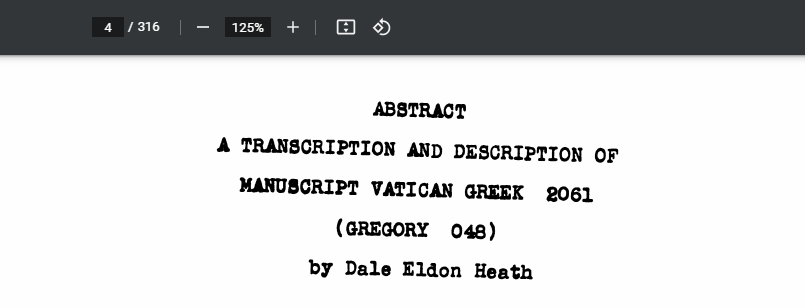
Here’s the transcription of the visible part of 1st John:
Here we switch to the other side of the folio leaf
At the end of the thesis Dale Heath gives a chart of the differences in the Vat. gr. 2061A to the Textus Receptus. Here’s the 1st John part:

As you can see the Comma Johanneum (or Johannine Comma or Johannine Parentheses) is indicated with a minus – symbol, showing it is not in this manuscript.
Now actual images of the manuscript.
In my last post on this manuscript, decent online images were not available, but since then they have been published on the Vatican’s DVL DIGIVATLIB (Vatican’s Digital Library) website.
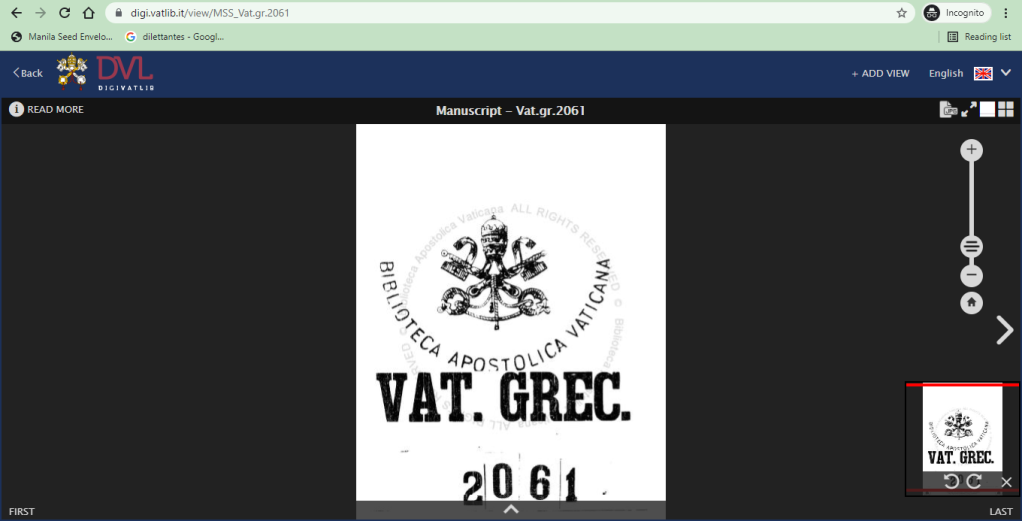
Vat. gr. 2061A (circa. 5th century C.E.)
Folio 308v
https://digi.vatlib.it/view/MSS_Vat.gr.2061.pt.A
Now images of folio 308v with the 1st John 5:7-8 text as the “scripto inferior” or underlying barely visible fifth century unical text.
Please note that there are two sets of photographs (standard photography and ultraviolet photographs).
It is the left hand marginal area that we are primarily interested in. This is where the 1st column out of the three columns on the page is actually visible, and this is also where the 1st John 5:7-8 (and preceding and following context) text is to be found (as published by Dale E. Heath).
Below are a few sample images zoomed in a little closer. You can go to the link given at the top to take a closer look yourself.

Now for those who aren’t familiar with the differences between unical or majuscule (all capitals) and cursive (lowercase) Greek script, I’m adding a slightly modified interlinear text of 1st John 5:7-8 from the Scripture4all NT Interlinear version which has unical (capital lettering) font which is close to the underlying Greek text in this manuscript.
Here’s Heath’s transcription of 1st John 5:7-8 with an image of the manuscript folio 308v itself:
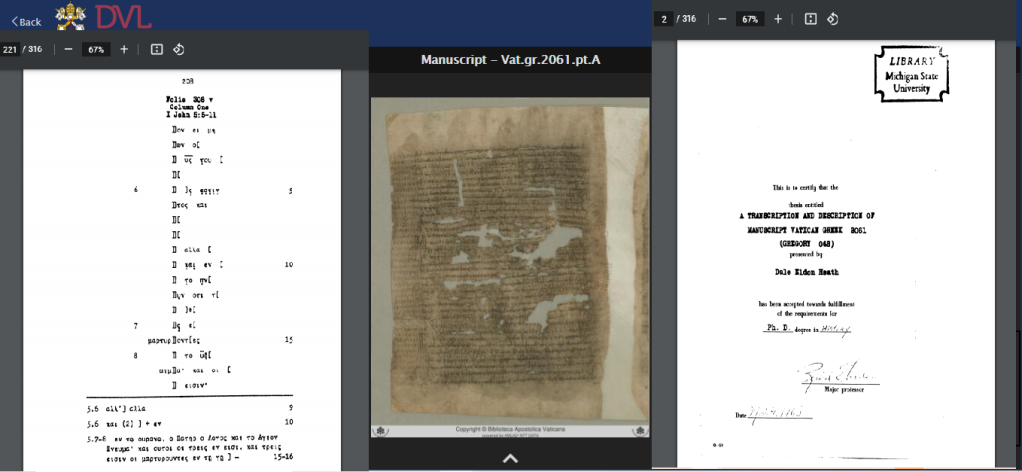
Now to make sense of Heath’s transcription, I’ve done a conjectural reconstruction of the full Greek text of most of (note most of – which is enough for our purposes – but not all of) the context on Folio 308v. The text in bolded black and with yellow highlighting behind it, corresponds to the visible script in Vat. gr. 2061A on Folio 308v in the left margin with Heath’s transcription.
Now, put alongside of Heath’s text and the manuscript:
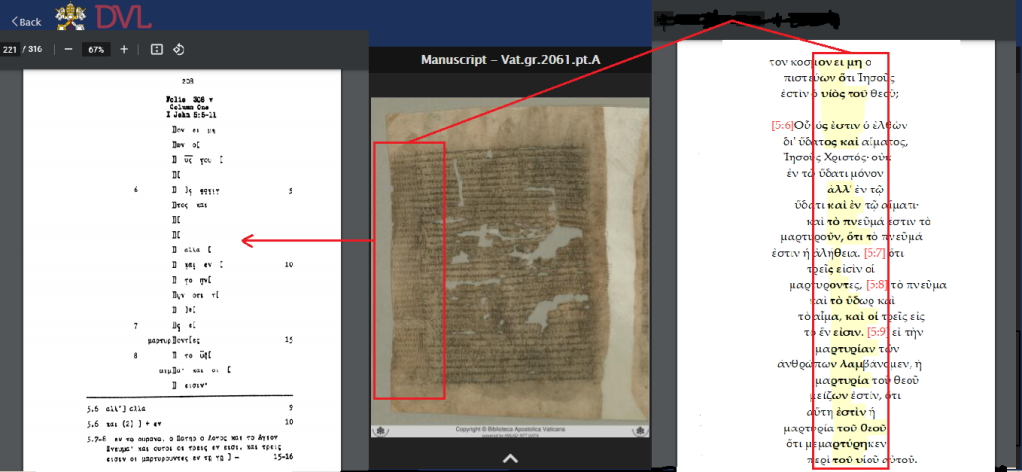
Here’s a close up image of the area where 1st John 5:7-8 is located on Folio 308v:
Now in ultraviolet light:
Well, you’re probably saying I can’t see anything, or make sense of how Heath came to his conclusions!
The next few images will help!
I’ve very roughly, with my computer mouse, drawn over the visible unical text, and put Heath’s text and mine along side.
Let’s look at with and without together:
There’s is simply not enough room in the margin, nor between the three columns per-page, nor does the (contra theorized/imagined) surviving actually visible text from both the immediately preceding and following contexts – make it even remotely possible that the Comma Johanneum is somehow somewhere hiding under the over-written text (as no doubt some conspiracy minded KJVO-Comma supporters may try/attempt to theorize).

Institute for New Testament Textual Research (Institut für Neutestamentliche Textforschung, INTF)
http://ntvmr.uni-muenster.de/about


No Comma Johanneum here!
This needed revisiting and updating.